808s are those huge, wall-shaking bass sounds found all across Hip Hop, EDM, and Pop.. but I’m sure you already know that. You aren’t here to learn anything about their history, no, you’re here because you want to know how to make an 808 bass from scratch. And I have good news for you because compared to other sounds, 808 are actually quite easy to make. In this Serum tutorial, you’ll learn everything you need to know.
We’re using Serum in this post, but most other synths should get the job done as well.
Step 0: Preparation
Before we start shaping the sound of your 808, we should talk about some basic settings all 808 presets should have in common:
1. Make it Monophonic
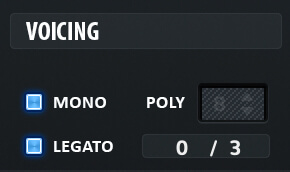
Most synths these days are polyphonic, which means that they can play multiple notes at once. However, making bass sounds you ALWAYS want only one note to play at the same time. To make Serum monophonic, just hit this small “MONO” knob right under “VOICING”.
2. Don’t Randomize the Phase
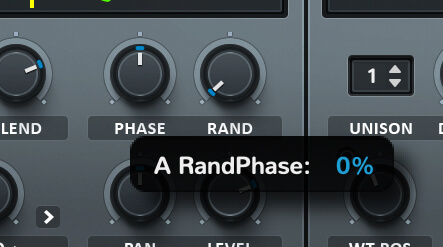
While making 808s, you usually want every hit to sound exactly the same. Therefore, you should disable everything that could potentially lead to unintentional randomness. So turn the “RAND” knob of the oscillator(s) you’re going to use all the way down in Serum.
Step 1: Choosing your Waveform
Once we got this out of the way it’s time to pick a waveform. Here are the common options:
Sine

A sine way provides only one frequency at the same time. This is the cleanest option and also the waveform the original 808 unit used for its kick drum.
Saw
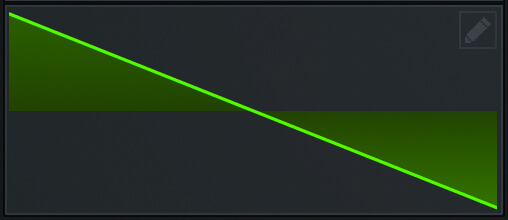
A saw, in contrast, comes with a lot of harmonic overtones and sounds kind of rattling. If you’re going for a saw, I’d highly recommend adding a low-pass filter afterward.
Other Waveforms
Obviously, there are plenty of additional waveforms to choose from. Some sound better and some worse as an 808. However, there aren’t any rules so feel free to try a bunch of different shapes before moving on. Hint: we made 137 wavetables specifically made for 808s. Feel free to check them out here.
Step 2: Adjust your Volume Envelope
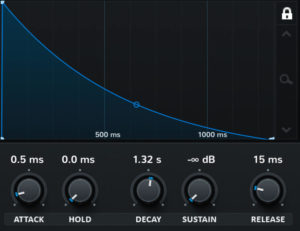
As you probably know, most 808s aren’t endlessly long. So in order to make your 808 slowly decrease its volume, turn down the Sustain and adjust the Decay to your liking. Some synths further allow shaping the envelope’s curve. In Serum, just drag this little dot and turn it up or down until you’re happy with the result. If you’re hearing clicks at the beginning or end of every note you’re playing you should also consider increasing the attack and release times.
Since we’re still at the beginning of the whole sound design process you shouldn’t spend too much time on these changes. They can still be tweaked and fine-tuned later on.
Step 3: Adding Pitch Modulations
Just like you can control the volume using an envelope you can use another envelope to control the pitch of your 808s. This is usually done to achieve 2 things:
1. Adding a Transient
In order to add a transient to your 808, you need a short envelope. Pick a decay time of about 80ms and turn the sustain all the way down again. Now drag the envelope to the “CRS” pitch and adjust the amount until you’re satisfied. When combining your 808 with a kick sample this step is NOT necessary all the time.
2. Slight Bassdrop
Once you’re done with the transient you can add another, longer envelope to the “FIN” tune of the same oscillator. For this purpose you could for example use the same envelope you’re using to control the volume. Just make sure that you aren’t overdoing it with the amount.
Step 4: Adding Noise
Another optional thing you can do to shape your 808’s sound is adding a tiny bit of noise. Enable the “NOISE” OSC on the left side by clicking the small box and adjust the volume. You can also try out different noise samples or pitching the noise up a bit. If you want the noise to hit only at the beginning of your 808 you could further add another envelope to its level.
Step 5: Distort your 808!
By now you probably noticed that your 808 doesn’t sound anything like to ones you can hear in the current Hip Hop charts. Why? Well, we haven’t added any distortion yet. Here are some of the things you can do to add harmonic overtones to your 808:
1. Warp Modes
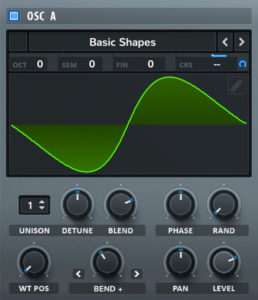
In order to add harmonics to your sine, you don’t even need to add any effects. Using Serum’s warp modes will already change up the harmonic structure of your waveform quite a lot. My favorite modes are definitely the “Bend” ones, but you can also get interesting results using the other stuff!
2. Serum’s Internal Effects
In addition to the warp modes, you can play around with Serum built-in effects.
These are my go-tos:
- Tube Distortion
- Filter Drive
- Hard Clipper
Protip: Using Serum FX you can combine multiple distortion algorithms.
3. External Plugins
When it comes to saturation or distortion, there are 2 plug-ins I want to highlight particularly.
Btw, I just wrote this post about the best 808 VSTs (also includes some free options).
So now that you got an overview of the different distortion options it’s time to f*ck around. Use different effects, tweak all the different knobs and try to use your ears to find out which things you really like. One last tip from my side: try to use different saturation “tools” in a row. For example tube distortion with a bit of hard clipping.
Step 6: What about the Kick?
Well, let’s be honest: 808s are nice, but they wouldn’t be half as cool without a decent punchy kick. Therefore, it’s quite important to have a library of hard-knocking, good-sounding kick drums in your pocket. If you don’t have one. Make sure to check out these free drum kits.
Step 7: The Group-Clipping-Trick
Before we call it a day, there’s one last trick I want to tell you about. First, group your kick, your closed hats, and optionally your 808 into a group. Now add a soft clipper to this group and start to slowly increase the gain. Once you reach a certain point, you’ll notice that the low frequencies (kick and bass) will cause the closed hats to distort in a way, which sounds extremely nice and bouncy in a lot of cases.


